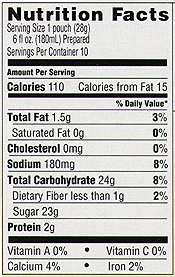
|
total calories calories from fat total fat saturated fat cholesterol sodium total carbohydrate |
dietary fiber sugars protein vitamin A vitamin C calcium iron |
Food - Nutrition |

|
total calories calories from fat total fat saturated fat cholesterol sodium total carbohydrate |
dietary fiber sugars protein vitamin A vitamin C calcium iron |
percent of calories
| mass equivalent
| total fat
| less than 30%
| less than 65 g
| saturated fat
| less than 10%
| less than 20 g
| carbohydrates
| 60%
| 300 g
| protein
| 10%
| 50 g
| |




| introduction | background | prelab | experiment | postlab |